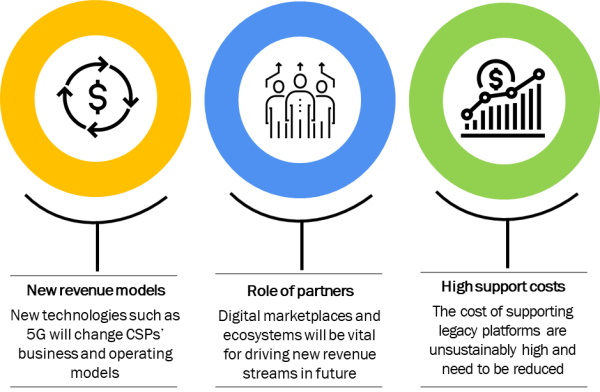SaaS delivery models will transform CSPs’ monetisation platforms
21 August 2020 | Research
Perspective | PDF (16 pages) | Monetisation Platforms| Digital Experience| Telecoms Strategy and Forecast
Communications service providers (CSPs) are facing many operational challenges: customer behaviour is changing, competition from digital-native service providers is increasing and network infrastructure requires urgent and significant investment. CSPs are also on the cusp of radical change to business and revenue models, thanks to the effect of the digital economy and 5G deployments. Therefore, CSPs are examining alternative models of software infrastructure development, deployment and management.
The main objective of CSPs, from an architecture design perspective, is to establish an agile, flexible and cost-effective foundation for the future. This is vital for mission-critical, customer-facing functions, such as those related to monetisation. Many CSPs continue to run monetisation systems on legacy platforms that are expensive to maintain and manage. The evolution of business and operating models and emerging use cases are forcing CSPs to accelerate transformation of their monetisation systems (see Figure 1). In this regard, CSPs want to ensure that their investments are future proof, the architecture is simplified and systems operate at a reduced cost. A growing number of CSPs are evaluating and deploying applications delivered in a software-as-a-service (SaaS) model. SaaS is increasingly viewed as the delivery model of the future and has been widely adopted in other industries such as retail and enterprise.
Figure 1: Key drivers of change to incumbent monetisation systems

SaaS is a product-centered approach to creating, deploying and managing software in which a software application vendor makes the application’s functionality available across a network. SaaS upends traditional software design and deployment approaches because it uses a delivery model that is fully based on a cloud-based infrastructure with the application provider taking complete responsibility for the software and the infrastructure, which significantly reduces CSPs’ overheads. The SaaS delivery model fosters a ‘start small and grow’ approach, which enables CSPs to control their spending, and supports flexible configurations without requiring expensive customisations and removing need for infrastructure management. The benefits of the SaaS model make it an important consideration for CSPs that are preparing to transform their monetisation systems.
The agility, configurability, upgradeability and operability of SaaS-based monetisation platforms can help to address many of CSPs’ monetisation-related pain points. This report looks at the factors driving extensive change in CSPs’ approaches to monetisation, the essential traits of monetisation platforms of the future and how SaaS has emerged as a viable alternative to traditional deployment models.
Subscription content
Log in to check if this content is included in your content subscription.
LoginRelated items
The future of wholesale commerce platforms for communications service providers
Strategy report
Vendors must improve the power efficiency of their products to tackle Scope 3 emissions
Article
Public cloud providers are tackling soaring emissions despite being leading purchasers of renewable energy
